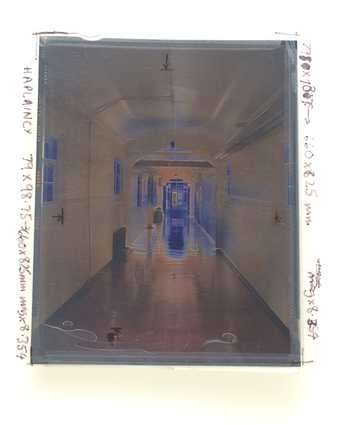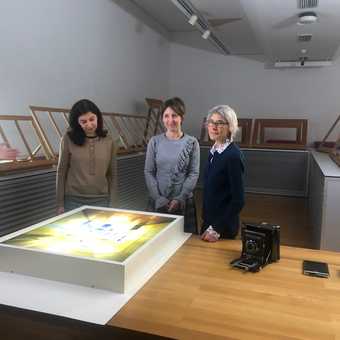
Members of the research team examining sample prints of Rineke Dijkstra’s Kolobrzeg, Poland, July 26 1992 1992. Taken on a day of close looking at Rineke’s work at Tate Store in October 2019, with colleagues from Tate and the Stedelijk Museum. This was a special opportunity to look at Rineke’s work, to ask questions, see test strips and sample prints in both natural and artificial light.
From left to right: artist Rineke Dijkstra, Yasufumi Nakamori (Senior Curator, International Art: Photography, Tate), Pip Laurenson (Head of Collection Care Research, Tate), Laurence Martin (Photograph Conservator, Tate)
This enterprise considers not only the material vulnerability of modern and contemporary colour photography but also the networks of skills, materials and technologies that support artists who work in this medium. The research supports the development of expertise in the conservation and stewardship of contemporary art photography at Tate and investigates innovative ways of approaching contemporary art photography across disciplines and institutions. As a dialogue between collection care and anthropology, the research touches many departments within Tate for example registration, conservation, curatorial, legal and staff from the research department.
This research supports the development of expertise in the conservation and stewardship of contemporary art photography at Tate and investigates innovative ways of approaching contemporary art photography across disciplines and institutions. As a dialogue between collection care and anthropology, it includes many different departments within Tate, such as registration, conservation, curatorial, legal and staff from the research department.

Components used in the production of Catherine Yass’s Corridors 1994, photographed in the artist’s studio
All colour photographic materials are vulnerable to the effects of light, but some colour photographic materials are more prone to colour shifts over time than others, even while in dark storage. Other photographic works may be unglazed and displayed in ways in which they are vulnerable to damage. Questions arise about how best to manage these photographic artworks and their display. Essential to making decisions about the care of these works is understanding how they were made and the infrastructure that supports that making as well as the artist’s response to the effects of aging.
The questions underpinning this area of research are therefore broad and include:
- What is the impact of changes in the appearance of particular works?
- Is reprinting a photograph acceptable within a contemporary art context?
- How reproducible is any given photograph?
- What are the networks of skills, materials and technologies that underpin processes of production and reproduction?
- How are these processes impacted by obsolescence and the rise of digital technologies?
- How has the commercial world of photography that supports the work of artists changed?
- How have changes in their commercial networks impacted the ways artists are working?
All the projects undertaken within this framework aim to support and inform emerging practice in the care of contemporary colour photographs and seek to unpack the skills and connections that underpin contemporary art photography in an environment of rapid technological change. Highly interdisciplinary, our work aims to facilitate dialogue across artistic, academic, institutional and commercial contexts.

